By Cleo Woelfle-Erskine
The latest installment of the series “Reimagining, remembering, and reclaiming water” discusses how new eco-cultural imaginaries can emerge from alliances for river restoration between ranchers-conservationists, salmon scientists, and Tribal natural resource staff.
Within North American settler colonial societies, Native nations, both those that are federally recognized and those that are not, make distinct but allied demands to settler governments to return stolen land and co-manage rivers, landscapes, and fisheries. In California and beyond, recognized and unrecognized tribes are expanding the lands that they manage, by buying land outright, pushing cities and state agencies to return land, forming land trusts, working with nonprofits to manage community forests and prairies, and negotiating cultural use areas within state parks. Tribal treaty rights guarantee co-management and the right to access and manage cultural and natural resources in Tribal territories. Where reservations were established after the treaty era, as with many Rancherias in California, federal and state law and policy support Tribal sovereignty and government-to-government relationships.
Indigenous scholars propose to understand these initiatives in relation to broader struggles to develop alternative eco-cultural imaginaries based on grounded relations to land. Thinking with Dakota scholar Kim TallBear, Potawatomie scholar Kyle Powys Whyte proposes that Native nations’ ecocultural revitalization projects “are invested in more expansive objectives of indigeneity that seek to undermine structures of industrial settler colonialism.” They further stress that those Indigenous and settler populations who are not members of a particular tribe “can and are expected to learn from and contribute to these projects though they do not, of course, somehow become members of the particular Tribes by doing so.” In other words, we settlers must push our governments to uphold commitments to Indigenous sovereignty, and work directly to support Indigenous eco-cultural revitalization, if incipient alliances are to produce new ways for people and other species to live together along rivers.
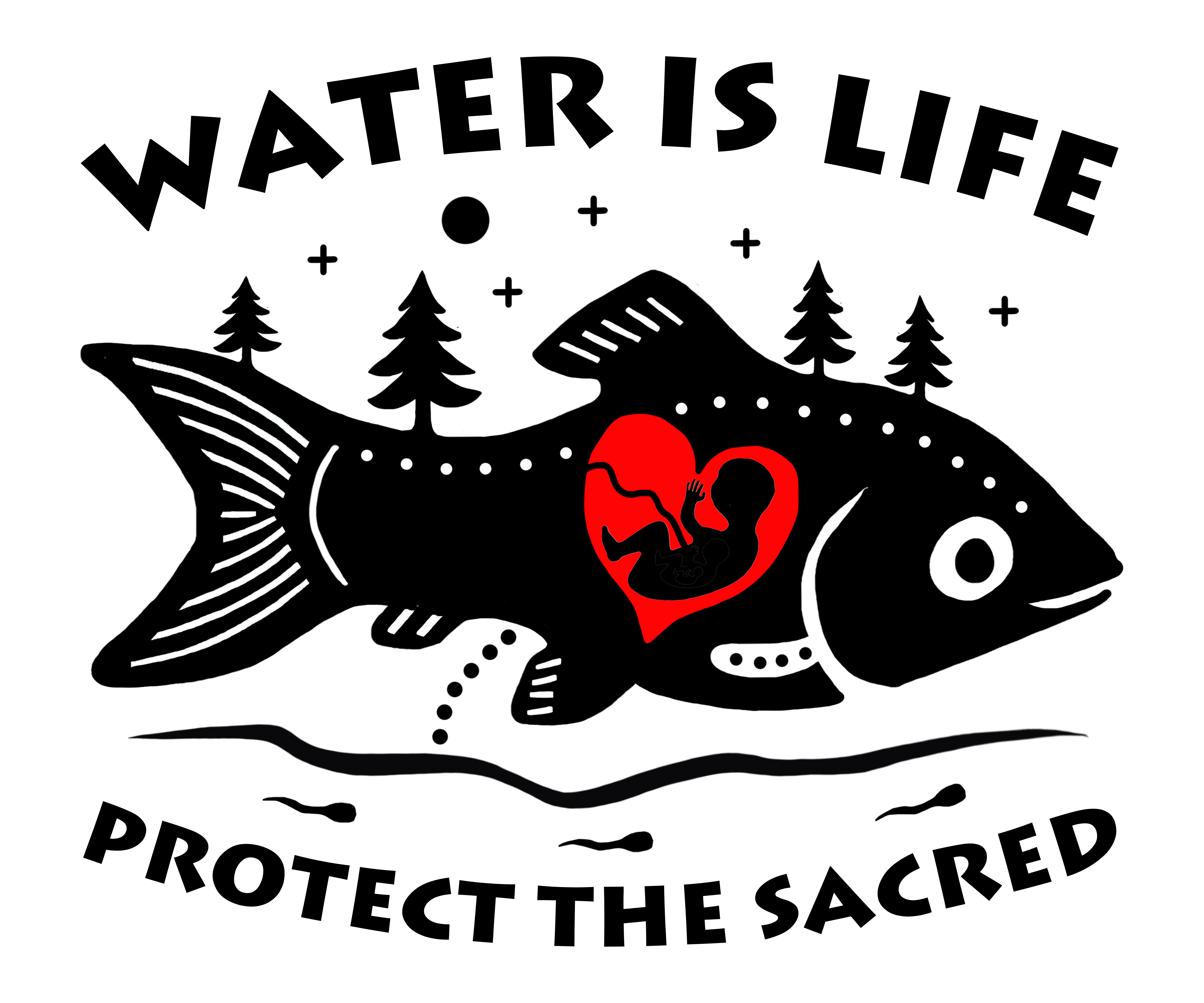
Poster by indigenous Michif visual artist Christi Belcourt from the Onaman Collective, a community-based social arts and justice organization, helping indigenous communities, particularly youth, with reclaiming their traditional arts with a contemporary spin. Source: Onaman Collective
What changes can such alliances can bring to local ways of living and broader environmental politics? Political ecologists Peet and Watts point to the new imaginaries of living together that people form in collective struggles for land and livelihood, constituting new “liberation ecologies.” As Indigenous studies scholars Glen Coulthard and Leanne Betasamosake Simpson argue, Indigenous imaginaries and legal orders flow from a “grounded normativity”, that is, a “[Native] relationship to the land itself [that] generates the processes, practices, and knowledges that inform our political systems, and through which we practice solidarity.” This idea foregrounds the idea of a multispecies commons, which I elaborate on below.
In the Scott Valley in California, emerging alliances between local and downriver Tribes and some ranchers and conservationists are transforming river restoration projects and improving conditions for endangered salmon who spawn and rear there. In my forthcoming book Underflows: Queer trans ecologies and river justice, I trace two imaginaries of how water flows through the surface, one rooted in the agricultural system and one in the salmon system. Here, I briefly describe a new imaginary that I see emerging as ranchers-conservationists, salmon scientists, and Tribal natural resource staff come together to tackle the giant piles of mine tailings left over from dredge mining for gold in the early 1900s, groundwater depletion, and climate change.
Some alliances between settlers and the Native nations on whose land they live have started to transfigure those governance processes from below. But most non-Native people don’t consult local Native nations as they manage land, water, wildlife and other natural and cultural resources; even fewer return land or engage in formal co-management. This settler colonialism as ongoing dispossession is evident in Salmon Creek, a small stream in northern California where I studied water politics and salmon extinction with local residents and local scientists, who were all settlers, and mostly white.
In my seven years of field collaborations in this community, I often witnessed people erase Pomo and Miwok sovereignty by not formally consulting with the Confederated Indians of Graton Rancheria. When asked why, one community scientist responded that Graton tribal members had lost their culture; another, a government scientist, said that because tribal members consulted anthropological records as they revived ecocultural practices, their traditional knowledge was not authentically Indigenous. J. Kēhaulani Kauanui’s conceptualization of commonplace, everyday erasure is useful in understanding this dynamic in Salmon Creek and across California, where settlers mobilize racist purity logics that see “living Indians as “mixed” and therefore no longer “truly Indian””. This insistence that Indians have vanished despite their continued presence is especially acute in California, where Congress either declined to ratify many treaties, or later dispossessed tribes of land and recognition.
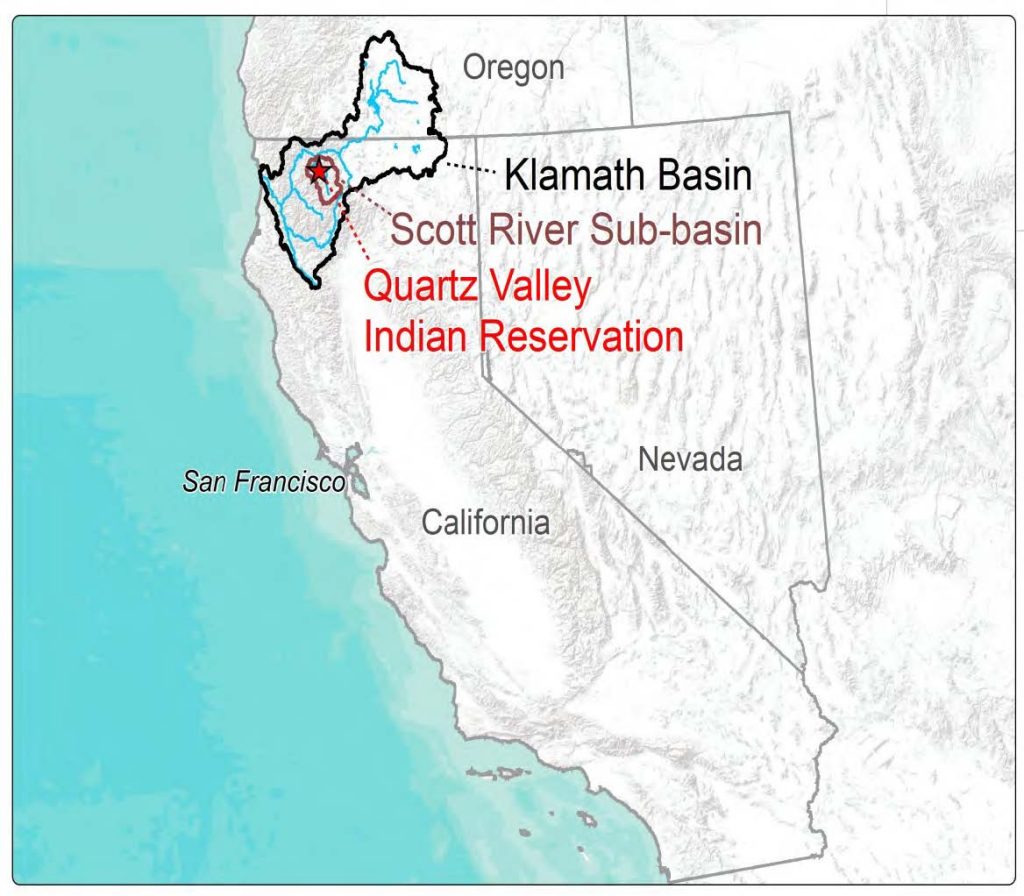
Source: Federated Indians of Graton Rancheria
Situated knowledge on the Klamath River
I first came to the Klamath River’s headwaters in eastern Oregon in 2004, to interview Klamath Tribe leaders and upper basin ranchers in the wake of a 2002 fish kill that precipitated the current dam removal effort. I found points of convergence around conservation ranching, Tribal forest management practices, and shared concern for salmon. In 2011, my classmate Daniel Sarna-Wojcicki and I found a similar convergence in the Scott Valley, which flows into the Klamath downstream of four salmon-blocking dams, around the idea of beaver-led restoration; I returned over the years to interview ranchers and Watershed Council members. In 2017, now a professor at UW Seattle, I began formally collaborating with the Watershed Council and the Quartz Valley Indian Community through a field course that brought together UW students with Karuk and Quartz Valley high-school interns to survey salmon, measure water quality, and explore groundwater-stream interactions.
In the Scott Valley my students and I are currently working with a team of economists, ecologists, and hydrologists to develop a computer model of groundwater pumping grounded in distinct imaginaries. With this model we can explore the long-term stability of farming profits and fishery growth, and propose groundwater pumping schedules that leave some water for salmon. By first conducting interviews and observing Groundwater Advisory Committee meetings, we are co-generating specific model architectures and inputs guided by Quartz Valley, the Watershed Council, and a rancher group’s priorities; these interviews are revealing nuances to salmon and cow-centric imaginaries.
My ongoing work in the Scott and Mid-Klamath watersheds begins with Indigenous research protocols and feminist commitments to situated knowledge, and to reflexivity—considering how the presence of a researcher influences what is being researched. Where a non-reflexive researcher might publish results without considering how they will affect ongoing negotiations or sensitive relationships among their collaborators, reflexivity guides me to work through Tribal protocol or local partners’ concerns when deciding what data to publish, and how to frame my findings.
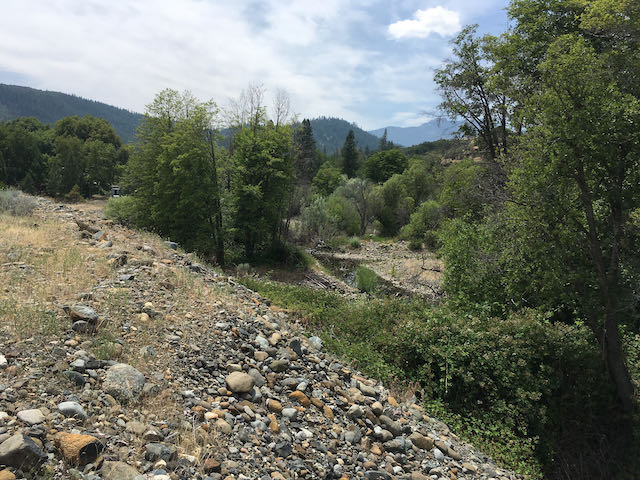
A beaver dam backs up water between dredge mining tailings on lower Sugar Creek, near the Scott River confluence. The beavers built this dam upstream of the beaver dam analogs installed and maintained by the Scott River Watershed Council.
In my work in the Scott Valley, I’ve used this approach to strengthen an emerging partnership between the Quartz Valley Indian Community, the Scott River Watershed Council, and the Karuk Tribe. I convened a 12-day field course that brought together Karuk high school students and University of Washington students to study juvenile salmon in four streams where these groups are experimenting with different streamflow and habitat restoration structures, including beaver dam analogs and off-channel ponds. Staff from the Watershed Council, Quartz Valley Environmental Protection Agency, and the Karuk Department of Natural Resources led field activities and shared their work on climate adaptation and restoration innovations; Quartz Valley interns joined in two days of stream surveys.
The Quartz Valley Indian Community was long shut out of county-run groundwater governance in the Scott Valley, until the 2014 California Sustainable Groundwater Management Act mandated all parties’ inclusion in the new groundwater sustainability agency. That these groups have begun to work closely signals a shift in imaginaries, at least temporarily, when they see strategic advantages in restoration and monitoring collaboration. Although the groups had long been in conversation about various restoration techniques, back in 2014, when the Watershed Council invited the Karuk Fisheries department to tag fish on Sugar Creek, the two groups focused on approaches. Karuk Fisheries dug off-channel ponds as salmon refuge, while the Scott River Watershed Council built beaver dam analogs.
Through conversations around the fish-tagging table and field trips to one another’ projects, both have expanded their repertoire of restoration techniques. By sharing methods and data, they have developed a more robust understanding of how groundwater influences stream temperature, which in turn shapes fish behavior. When streams get too warm, juvenile salmon seek out cool, deep pools. In many Mid-Klamath tributaries, this pool habitat is scarce, but off-channel ponds built by people, and ponds built by beavers (with some help from beaver dam analogs) create this cold-water habitat, and recharge groundwater into the surrounding floodplain.
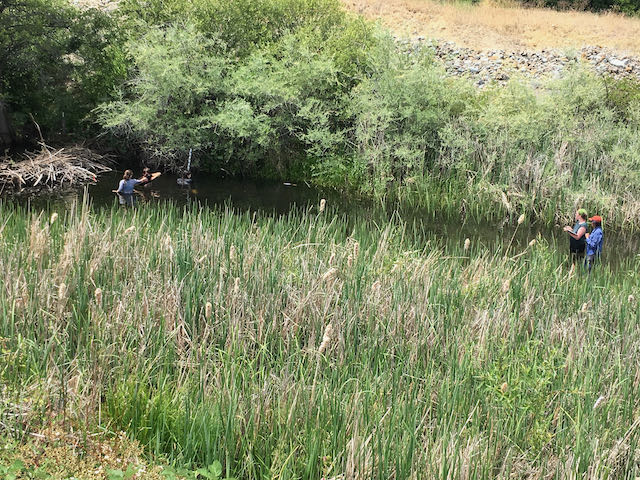
University of Washington students measure depth and water quality and count juvenile salmonids in the Sugar Creek beaver pond; the beaver dam is visible in the upper left.
Making multispecies commons with salmon and beavers
As fish- and farm-centric imaginaries have converged around groundwater recharge by floodplain reconnection, more Tribal-NGO partnerships are emerging. In 2015, Quartz Valley and the Watershed Council had begun collaborating on a summer program that brings tribal and non-tribal youth together to do watershed restoration work. Quartz Valley and SRWC now share data and are collaborating on funding proposals for stream restoration, while using different strategies to increase streamflow and recharge groundwater. Quartz Valley, concerned about streamflows throughout the Scott Basin, presents an argument that rests on an imaginary that challenges settler governance practices of managing groundwater, streamflow, and salmon separately.
To sustain salmon and their multispecies commons, this imaginary requires that ground and surface water be managed together, and considered as a tribal trust. Quartz Valley has exercised tribal sovereignty by petitioning for “treatment as a state” under the Clean Water Act. Treatment as a state has given the Tribe the authority to govern water resources on the Reservation and pursue issues upstream of the Reservation that may be impacting the river and the aquatic resources downstream at its boundaries. This appeal to treaty law and adjudication aims to mitigate the legacy of nearly two-centuries of settler-colonial land and water management and restore the stream to a flowing, vibrant life source on the Quartz Valley reservation. It is the latest strategy in Quartz Valley’s struggle to manage salmon throughout the Scott Valley, by demanding changes in irrigation and enforcement of state fish and wildlife codes.
A new SRWC-Quartz Valley partnership grows from their mutual interest in recovering salmon while developing local economies and infrastructures so that they are resilient in the face of climate change and decreasing snowpack. One topic of shared interest is beavers’ improvements to salmon habitats, and shared interest in understanding how much beaver dams (and human-made “beaver dam analogs”) can recharge aquifers. As they begin to work with the Scott River Watershed Council on restoration of Shackleford Creek, Quartz Valley natural resources staff wants to know more about how much groundwater beaver dams recharge, and to ensure that rising water tables are not used to justify excessive diversions from ditches and wells. The Tribe recognizes that BDAs improve habitat locally, but want to know definitively the extent of the impact on the water table. To this end, the Tribe has decided to build some test BDAs on Shackleford Creek, where they have an extensive and long-standing monitoring well network, then evaluate how the water table and fish respond.
That such collaborations are happening at all represents a marked shift in Scott Valley politics. How these temporary alliances will shift underlying imaginaries remains to be seen, but in the meantime, Native and non-Native salmon advocates keep building habitats and testing strategies in the stream.
Note on process: This piece evolved from an ongoing collaboration with members of the Scott Valley restoration community, and touches on themes that I explore in more depth in my forthcoming book. Throughout the process of writing and revising the chapter and this piece, I shared the text with collaborators and responded to their critiques. Their main comment was that the collaborations between Tribes and NGOs in the Valley have deepened in recent years, and work on restoration projects has built trust and personal relationships. I value these critiques and the time these collaborators have taken to engage with my work deeply, and hope that I have done justice to their comments.
—
Cleo Woelfle-Erskine is an Assistant Professor in the School of Marine and Environmental Affairs, University of Washington. He partners with Native nations, agencies, community scientists, and local activists to collaboratively study the hydro-ecological and environmental justice dimensions of river and salmon recovery. Cleo’s book Underflows: Queer trans ecologies and river justice is forthcoming (Fall 2021) from the University of Washington Press.
Featured image (Top): University of Washington students Susannah Maher (left) and Kim Yazzie (right) collect data on French Creek with a community member (center) during a 2018 field course.


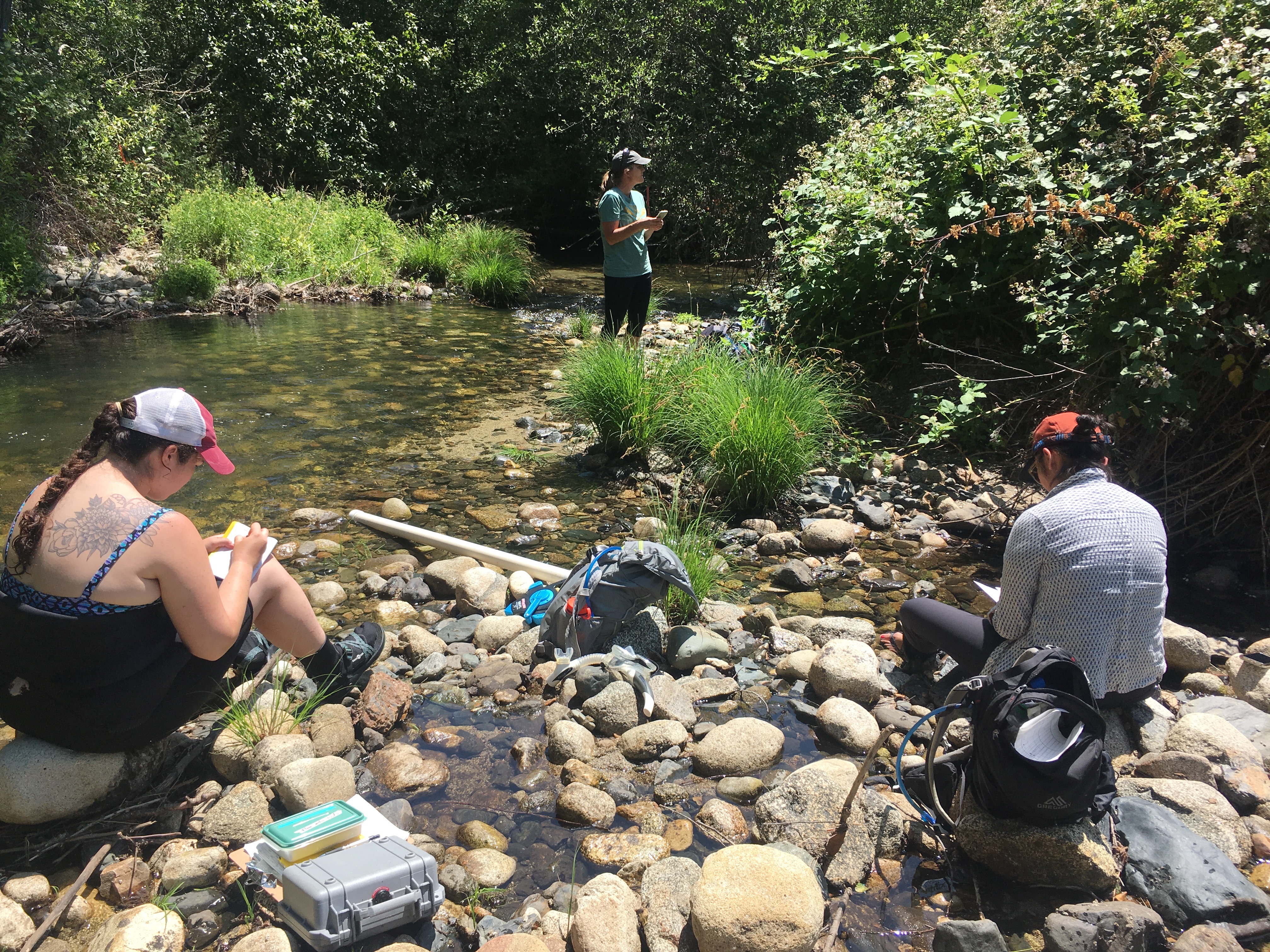



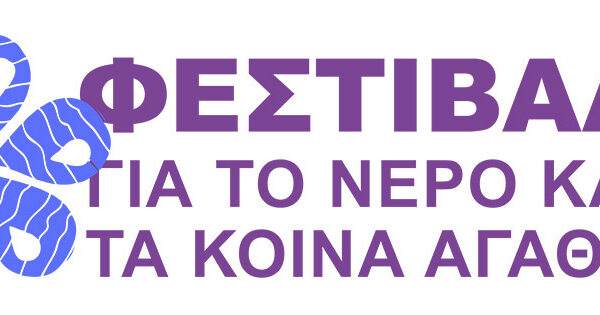
2 Comments